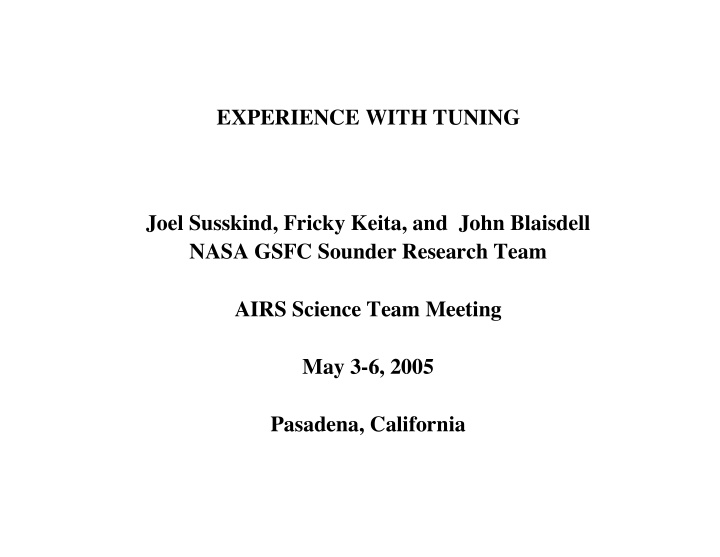



EXPERIENCE WITH TUNING Joel Susskind, Fricky Keita, and John Blaisdell NASA GSFC Sounder Research Team AIRS Science Team Meeting May 3-6, 2005 Pasadena, California
OVERVIEW Suggested changes from Version 4.0 to Version 4.2 Tuning experiments using Version 4.2 Experiment with physics error estimate
VERSION 4.2 We have made a number of minor modifications to GSFC Version 4.0 • Include AMSU A channels in combined surface and T(P) retrievals were in JPL Version 4.0 • Add 11 IR channels from 727.87 cm -1 - 755.33 cm -1 to physical T(P) retrieval Now 69 channels • Force at least 3 iterations before terminating constituent profile retrievals • Eliminate 3 steps from physical retrieval Based on suggestions by Chris Barnet
VERSION 4.0 STEPS IN PHYSICAL RETRIEVAL 1. AMSU/STRAT IR retrieval - uses MW product � 1 , ˆ 1 2. Determine R i 1 ˆ 3. Regression - first product using R i 4. AMSU/STRAT IR retrieval - uses first product Determine η 2 , R i 2 5. 2 – gives T s 1 ε i 1 6. AIRS surface retrieval using R i 1 7. AMSU/STRAT IR retrieval using T s � 3 , ˆ 3 8. Determine R i 3 ˆ 9. AIRS surface, T(P), q(P), O 3 (p) retrievals using R i 10. AMSU/STRAT IR retrieval � 4 , ˆ 4 11. Determine R i 4 ˆ 12. Repeat surface and T(P) retrievals using R i Steps 5-7 have been eliminated in Version 4.2 ˆ , R are computed only 3 times � i Program runs 10% faster - results slightly better �
AIRS TUNING COEFFICIENTS Form of tuning � ( ) ( ) comp comp ˆ ˆ ˆ ˆ A � � � = � � � + i i i i i � ( ) comp Use in all retrieval steps ˆ � � � i i ( ) truth ˆ A i derived as the mean of � � � i i 5138 “clear” ocean night cases on September 6, 2002 truth Colocated ECMWF forecast used to compute � i appears stable over space and time A i is used only for channels in the spectral ranges 600 cm -1 - 756 cm -1 and A i 2180 cm -1 - 2422 cm -1
EXPERIMENTS WITH TUNING COEFFICIENTS Use Version 4.2 with tuning coefficients generated on September 6, 2002 Test on January 25, 2003 and March 6, 2005 Compare with colocated ECMWF forecast Run retrievals with baseline tuning, no tuning, no 15 µ m tuning, no 4 µ m tuning Based on observed results, we ran with 15 µ m tuning as is and double 4 µ m tuning
EXPERIMENT WITH “PHYSICS ERROR” TERM We currently add a term to the diagonal of the channel noise covariance matrix to allow N ii comp for random physics errors in R i is empirical, and roughly constant at a level of 0.3K N ii as is already includes 0.1K for all channels before adding other terms N ii Methodology can most likely be improved comp We currently have no term reflecting uncertainty of due to uncertainty in CO 2 amount R i N ii We set to all channels and compared results with as is N ii = 0 N ii With baseline tuning With no IR tuning
SUMMARY In Version 4.2 Results degrade compared to ECMWF if all IR tuning is removed Results improve if 4 µ m tuning coefficients are doubled Results degrade if is set equal to zero N ii However Findings may be due to artifacts in the retrieval system as is More research is needed to eliminate or minimize tuning and “physics error” terms This must be done before we can set these coefficients to zero without degrading results
Recommend
More recommend